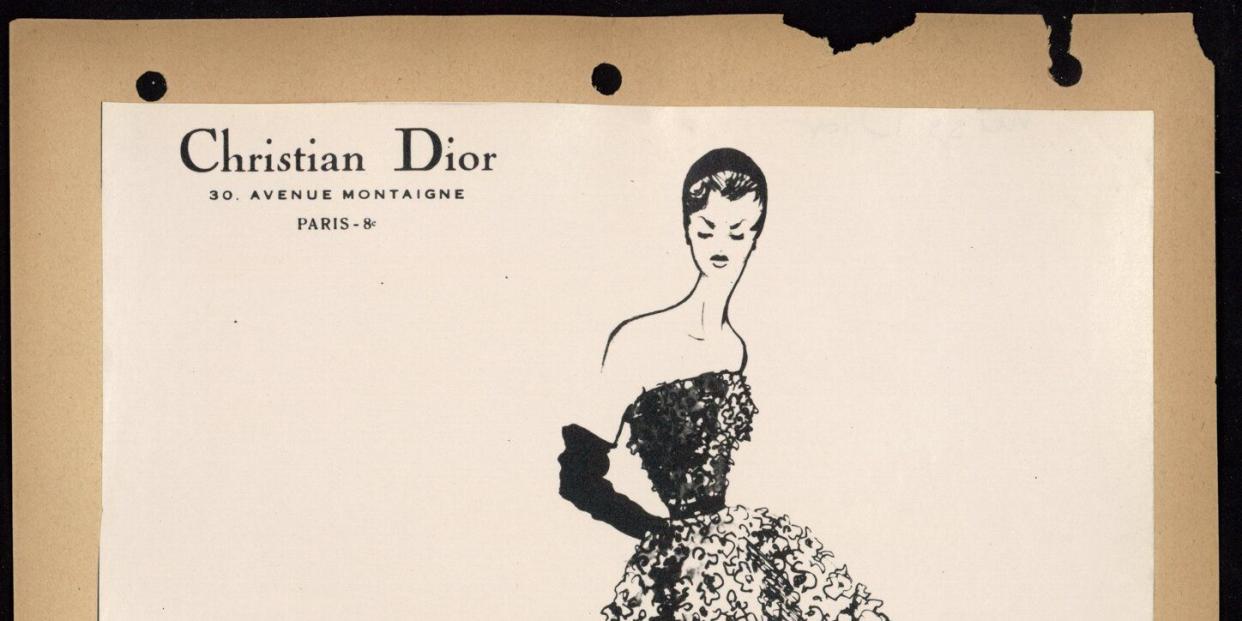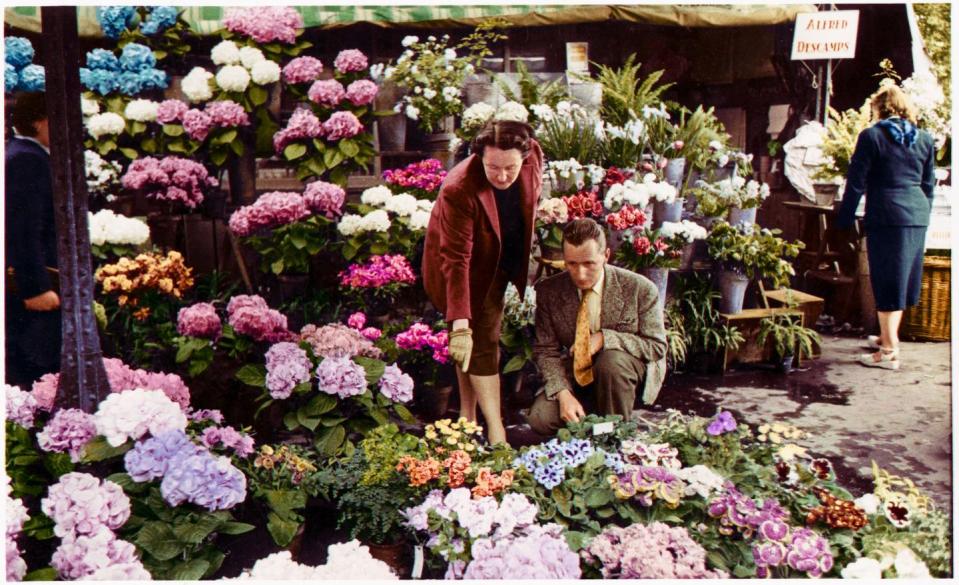The Story Behind Christian Dior’s Iconic ‘Miss Dior’ Dress

- Oops!Something went wrong.Please try again later.
You’re likely familiar with the Miss Dior perfume, Christian Dior’s signature fragrance, but the woman it’s based on is far less known. In Miss Dior: A Story of Courage and Couture (Farrar, Straus and Giroux), author Justine Picardie puts the spotlight on Catherine Dior, the designer’s youngest sister, who served as inspiration for much of his work. A persevering woman and advocate of the French Resistance, Catherine’s penchant for flowers earned her the nickname “Miss Dior,” which became the scent, and ultimately, the iconic dress “With a Thousand Flowers.” Read an exclusive excerpt below about how the artfully embroidered house staple came to be.
Did Christian Dior have his sister Catherine in mind when he designed this superb dress, as a tribute to her love of flowers? The name would suggest so, and he certainly gave Catherine outfits from each of his collections, yet it seems unlikely that she would ever have chosen to wear the Miss Dior dress. By 1949, Catherine and Hervé des Charbonneries had moved out of Christian’s apartment on Rue Royale, and were living nearby in a home of their own, at 49 Rue Montorgueil. It was close to the market at Les Halles, and convenient for their fresh-flower business; although they continued to spend every summer at Les Naÿssès, which Catherine had inherited after her father’s death. There, she tended her garden and the fields of jasmine and roses that were key ingredients for the production of Dior perfume.
The pictures that I have seen of Catherine in her post-war life show her at ease in linen trousers and shirts in Provence, or discreetly attired for work in Paris. Occasionally, there are surprises in these photographs: a bold plaid jacket worn on a city street, as Catherine walks arm in arm with Hervé; a striking leopard-print Dior coat, donned for the wedding of two close friends (the groom a former comrade in their Resistance network; the bride a relative of Hervé’s). Catherine looks well-dressed, but there is little evidence of the elaborate padding and traditional corsetry that were essential elements of Dior couture, which he dubbed “ephemeral architecture, dedicated to the beauty of the female body.” Instead, she appears to be wearing her clothes simply to get on with life, rather than as a means to display her brother’s consummate artistry. Hence the intriguing juxtaposition that exists in a photograph of Catherine taken in 1987 at a retrospective exhibition of her brother’s work at the Musée des Arts Décoratifs: she is wearing a modest dark coat, and standing beside a mannequin in an extravagant Dior ensemble, complete with a cartwheel hat. Catherine is gazing at the flamboyant outfit with the faintest hint of a quizzical expression on her face.

At first, as I began to explore Catherine’s history, and realized that she was more or less invisible to Christian’s acolytes, I felt angry on her behalf. And then I wondered how Catherine had navigated the arena of Parisian fashion, with its brittle etiquette, guarded cliques, and whispered gossip. Was she received with respect when she came to see her brother’s couture collections at Avenue Montaigne, amidst the chattering swarm of journalists, editors, celebrities, and socialites? Did they even recognize her as Christian’s sister, or appreciate her association with Miss Dior?
But I have come to believe that Catherine was possessed of a rare grace and inner strength that would have protected her from the jostling fashion crowd, with their sharp elbows, narrowed eyes, and stiletto heels. Catherine knew who she was. She had walked to hell and back. She loved her brother, and applauded his success, but she did not need the protection or disguise of his clothes. In the images that show Catherine wearing a Dior dress—for example, in the garden at Les Naÿssès, a glass of wine in her hand, or at the christening of her godson Nicolas, cradling him close—she still looks entirely herself.

As for the uncertainty regarding Catherine’s relationship with the Miss Dior dress: a clue may lie in the name of the collection where the gown first appeared, which Christian himself baptized the “Trompe-l’œil” line. The literal translation of the phrase is “deceiving the eye”; what might be the visual illusion at work here? That the flowers of the Miss Dior gown were real? That the original Miss Dior was untouched by the horrors of war, remaining safely in the past, an innocent young girl in the rose garden of Granville? Or is it simply as Dior described it in the program notes for the collection: “There are two principles on which the ‘Trompel’œil’ line is founded: one is to give the bust prominence and breadth, at the same time as respecting the natural curve of the shoulders; the other principle leaves the body its natural line but gives fullness and indispensable movement to the skirts.”
Yet the calm professionalism of this explanation is at odds with the emotional intensity that Dior reveals in his memoir, when he declares that he is “obsessed” with the clothes he creates: “They preoccupy me, they occupy me, and finally they ‘post-occupy’ me, if I can risk the word. This half vicious, half ecstatic circle, makes my life at the same time heaven and hell.” The passionate art of his couture therefore resists being fully dismantled, and examined as a logical, rational craft. His most precious designs may have seemed alive to him—whether as beloved daughters or trusted friends—but they also possessed him, embodying an idealized version of femininity that could never exist in a real woman. Miss Dior is born of a dream, a compulsive desire to create perfection. Adored by her maker, she seems more than an artifact. But like the alchemist’s treasured doll in Hoffmann’s eerie tale of The Sandman, she is unable to take on a life of her own.
Justine Picardie is a contributing editor at Harper’s Bazaar UK and author of Miss Dior: A Story of Courage and Couture (Farrar, Straus and Giroux), from which this is excerpted.
You Might Also Like

